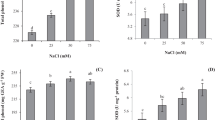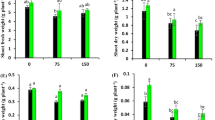Abstract
Salinity is a widespread adverse environmental problem globally, and significantly limits crop production. In this study, the possibility of enhancing salinity stress tolerance of Swiss chard (Beta vulgaris L. var. cicla) by 5-aminolevulinic acid (ALA) foliar application was investigated. The Swiss chard plants were grown in hydroponic culture. Twelve-week-old uniform seedlings were treated by 0 and 40 mM saline regimes generated by the mixture of sodium chloride and sodium sulfate (molar ratio NaCl:Na2SO4 = 9:1), and were foliar-sprayed with 0 and 60 μM L−1 ALA (every 3 days) for 6 days; then the plants were treated for another 7 days (every 3 day) with increased concentration of salinity and ALA, 80 mM and 120 μM L−1. Salinity without ALA application significantly decreased plant growth [43 % in shoot dry weight (DW), 21 % in root DW, 24 % in relative growth rate (RGR), 43 % in leaf area (LA)], water uptake [20.8 % in relative water content (RWC), 47.9 % in osmotic potential (OP)], chlorophyll (Chl) a content (10 %), Pn (36 %), Gs (72 %) and Tr (59 %) compared with those in control plants; however, under saline conditions, ALA foliar application improved plant growth (49.7 % in shoot DW, 27 % in root DW, 42.3 % in RGR, 72.1 % in LA) and increased RWC (12 %), Chl a content (10 %) and photosynthetic parameters (27 % in Pn, 28 % in Gs, 14 % in Tr) compared with those in untreated plants. Salinity significantly increased Na+ content, resulting in the reduction of Mg2+ and K+ contents. ALA foliar application alleviated ionic toxicity through the reduction of Na+ content and Na+/K+ ratio. On the other hand, it increased total nitrogen and glycine betaine (GB) content. ALA foliar application slightly reduced malondialdehyde (MDA) content, indicating that ALA has the potential to alleviate oxidative stress in salinity-stressed Swiss chard.





Similar content being viewed by others
Abbreviations
- ALA:
-
5-Aminolevulinic acid
- RGR:
-
Relative growth rate
- Pn :
-
Apparent photosynthetic rate
- Tr :
-
Transpiration rate
- Gs :
-
Stomatal conductance
- MDA:
-
Malondialdehyde
- DW:
-
Dry weight
- Chl:
-
Chlorophyll
- RWC:
-
Relative water content
- GB:
-
Glycine betaine
- OP:
-
Osmotic potential
- LA:
-
Leaf area
References
Aarti D, Tanaka R, Ito H, Tanaka A (2007) High light inhibits chlorophyll biosynthesis at the level of 5-aminolevulinate synthesis during de-etiolation in cucumber (Cucumis sativus) cotyledons. Photochem Photobiol 83:171–176
Akram NA, Ashraf M (2013) Regulation in plant stress tolerance by a potential plant growth regulator, 5-aminolevulinic acid. J Plant Growth Regul. doi:10.1007/s00344-013-9325-9
Arnon DI (1949) Copper enzymes in isolated chloroplasts. Polyphenoloxidase in Beta vulgaris. Plant Physiol 24:1–15
Ashraf M, Foolad MR (2007) Roles of glycine betaine and proline in improving plant abiotic stress resistance. Environ Exp Bot 59:206–216
Averina NG, Gritskevich ER, Vershilovskaya IV, Usatov AV, Yaronskaya EB (2010) Mechanisms of salt stress tolerance development in barley plants under the influence of 5-aminolevulinic acid. Rus J Plant Physiol 57:792–798
Awad MA (2008) Promotive effects of 5-aminolevulinic acid-based fertilizer on growth of tissue culture-derived date palm plants (Phoenix dactylifera L.) during acclimatization. Sci Hortic 118:48–52
Bates LS, Waldren RP, Teare ID (1973) Rapid determination of free proline for water-studies. Plant Soil 39:205–207
Bor M, Özdemir F, Türkan I (2003) The effect of salt stress on lipid peroxidation and antioxidants in leaves of sugar beet Beta vulgaris L. and wild beet Beta maritima L. Plant Sci 164:77–84
Chaves MM, Flexas J, Pinheiro C (2009) Photosynthesis under drought and salt stress: regulation mechanisms from whole plant to cell. Ann Bot 103:551–560
Colla G, Rouphael Y, Rea E, Cardarelli M (2012) Grafting cucumber plants enhance tolerance to sodium chloride and sulfate salinization. Sci Hortic 135:177–185
Demiral T, Türkan I (2006) Exogenous glycinebetaine affects growth and proline accumulation and retards senescence in two rice cultivars under NaCl stress. Environ Exp Bot 56:72–79
Dubey RS (2005) Photosynthesis in plants under stressful conditions. In: Pessarakli M (ed) Handbook of photosynthesis, 2nd edn. CRC Press, New York, pp 717–718
Fu JM, Huang BR (2001) Involvement of antioxidants and lipid peroxidation in the adaptation of two cool-season grasses to localized drought stress. Environ Exp Bot 45:105–114
Hara M, Takahashi I, Yamori M, Tanaka T, Funada S, Watanabe K (2011) Effects of 5-aminolevulinic acid on growth and amylase activity in the radish taproot. Plant Growth Regul 64:287–291
Hotta Y, Tanaka T, Takaoka H, Takeuchi Y, Konnai M (1997) Promotive effects of 5-aminolevulinic acid on the yield of several crops. Plant Growth Regul 22:109–114
Hu YC, Schmidhalter U (2005) Drought and salinity: a comparison of their effects on mineral nutrient of plants. J Plant Nutr Soil Sci 168:541–549
Hu LX, Hu T, Zhang XZ, Pang HC, Fu JM (2012) Exogenous glycine betaine ameliorates the adverse effect of salt stress on perennial ryegrass. J Am Soc Hortic Sci 137:38–46
Hunt R (1990) Basic growth analysis: plant growth analysis for beginners. Unwin Hyman, London
Keeling C, Ireland CR (2009) Characterization of saline tolerance in Swiss chard (Beta vulgaris spp. cicla L.): a potential novel crop for production on saline soils. Comp Biochem Physiol Part A 153:S217–S218
Korkmaz A (2012) Effects of exogenous application of 5-aminolevulinic acid in crop plants. In: Ahmad P, Prasad MNV (eds) Abiotic stress responses in plants. Springer, Berlin, pp 215–234
Li XY, Liu JJ, Zhang YT, Lin JX, Mu CS (2009) Physiological responses and adaptive strategies of wheat seedlings to salt and alkali stresses. Soil Sci Plant Nutr 55:680–684
Liu D, Pei ZF, Naeem MS, Ming DF, Liu HB, Khan F, Zhou WJ (2011) 5-Aminolevulinic acid activates antioxidative defence system and seedling growth in Brassica napus L. under water-deficit stress. J Agron Crop Sci 197:284–295
Liu L, Ueda A, Saneoka H (2013) Physiological responses of white Swiss chard (Beta vulgaris L. subsp. cicla) to saline and alkaline stresses. Aust J Crop Sci 7:1046–1052
Lutts S, Majerus V, Kinet JM (1999) NaCl effects on proline metabolism in rice (Oryza sativa) seedlings. Physiol Plant 105:450–458
Martino CD, Delfine S, Pizzuto R, Loreto F, Fuffi A (2003) Free amino acids and glycine betaine in leaf osmoregulation of spinach responding to increasing salt stress. New Phytol 158:455–463
Masuda T, Fujita Y (2008) Regulation and evolution of chlorophyll metabolism. Photochem Photobiol Sci 7:1131–1149
Maynard DN, Hochmuth GJ (2007) Vegetables and vegetable industry. Knott’s handbook for vegetable growers, 5th edn. Wiley, Hoboken, pp 1–53
Meloni DA, Gulotta MR, Martínez CA, Oliva MA (2004) The effects of salt stress on growth, nitrate reduction and proline and glycinebetaine accumulation in Prosopis alba. Braz J Plant Physiol 16:39–46
Munns R, Tester M (2008) Mechanisms of salinity tolerance. Annu Rev Plant Biol 59:651–681
Naeem MS, Jin ZL, Wan GL, Liu D, Liu HB, Yoneyama K, Zhou WJ (2010) 5-Aminolevulinic acid improves photosynthetic gas exchange capacity and ion uptake under salinity stress in oilseed rape (Brassica napus L.). Plant Soil 332:405–415
Naeem MS, Rasheed M, Liu D, Jin ZL, Ming DF, Yoneyama K, Takeuchi Y, Zhou WJ (2011) 5-Aminolevulinic acid ameliorates salinity-induced metabolic, water-related and biochemical changes in Brassica napus L. Acta Physiol Plant 33:517–528
Naeem MS, Warusawitharana H, Liu HB, Liu D, Ahmad R, Waraich EA, Xu L, Zhou WJ (2012) 5-Aminolevulinic acid alleviates the salinity-induced changes in Brassica napus as revealed by the ultrastructural study of chloroplast. Plant Physiol Biochem 57:84–92
Nguyen H, Calvo Polanca M, Zwiazek JJ (2006) Gas exchange and growth responses of ectomycorrhizal Picea mariana, Picea glauca, and Pinus banksiana seedlings to NaCl and Na2SO4. Plant Biol 8:646–652
Nishihara E, Kondo K, Parvez MM, Takahashi K, Watanabe K, Tanaka K (2003) Role of 5-aminolevulinic acid (ALA) on active oxygen-scavenging system in NaCl-treated spinach (Spinacia oleracea). Plant Physiol 160:1085–1091
Parida AK, Das AB (2005) Salt tolerance and salinity effects on plants: a review. Ecotoxicol Environ Saf 60:324–349
Pyo YH, Lee TC, Logendra L, Rosen R (2004) Antioxidant activity and phenolic compounds of Swiss chard (Beta vulgaris subspecies cycla) extracts. Food Chem 85:19–26
Renault S, Croser C, Franklin JA, Zwiazek JJ (2001) Effects of NaCl and Na2SO4 on red-osier dogwood (Cornus stolonifera Michz) seedlings. Plant Soil 233:261–268
Saneoka H, Moghaieb REA, Premachandra GS, Fujita K (2004) Nitrogen nutrition and water stress effects on cell membrane stability and leaf water relations in Agrostis palustris Huds. Environ Exp Bot 52:131–138
Sasaki K, Watanabe M, Tanaka T, Tanaka T (2002) Biosynthesis, biotechnological production and applications of 5-aminolevulinic acid. Appl Microbiol Biotechnol 58:23–29
Shabala S, Cuin TA (2008) Potassium transport and plant salt tolerance. Physiol Plant 133:651–669
Shaul O (2002) Magnesium transport and function in plants: the tip of the iceberg. Biometals 15:309–323
Sosa L, Llanes A, Reinoso H, Reginato M, Luna V (2005) Osmotic and specific ion effects on the germination of Prosopis strombulifera. Ann Bot-Lond 96:261–267
Turner NC (1981) Technique and experimental approaches for the measurement of plant water status. Plant Soil 58:339–366
Wang LJ, Jiang WB, Liu H, Liu WQ, Kang L, Hou XL (2005) Promotion by 5-aminolevulinic acid of germination of pakchoi (Brassica campestris ssp. chinensis var. communis Tsen et Lee) seeds under salt stress. J Integr Plant Biol 47:1084–1091
Watanabe K, Tanaka T, Hotta Y, Kuramochi H, Takeuchi Y (2000) Improving salt tolerance of cotton seedlings with 5-aminolevulinic acid. Plant Growth Regul 32:99–103
Wongkantrakorn N, Sunohara Y, Matsumoto H (2009) Mechanism of growth amelioration of NaCl-stressed rice (Oryza sativa L.) by δ-aminolevulinic acid. J Pestic Sci 34:89–95
Yang WJ, Nadolska-Orczyk A, Wood KV, Hahn DT, Rich PJ, Wood AJ, Saneoka H, Premachandra GS, Bonham CC, Rhodes JC, Joly RJ, Samaras Y, Goldsbrough PB, Rhodes D (1995) Near-isogenic lines of maize differing for glycinebetaine. Plant Physiol 107:621–630
Yousif BS, Nguyen NT, Fukuda Y, Hakada H, Okamoto Y, Masaoka Y, Saneoka H (2010) Effect of salinity on growth, mineral composition, photosynthesis and water relations of two vegetable crops; new Zealand spinach (Tetragonia tetragoniodes) and water spinach (Ipomoea aquatic). Int J Agric Bio 12:211–216
Zhang JT, Mu CS (2009) Effects of saline and alkaline stresses on the germination, growth, photosynthesis, ionic balance and anti-oxidant system in an alkali-tolerant leguminous forage Lathyrus quinquenervius. Soil Sci Plant Nutr 55:685–697
Zhang ZJ, Li HZ, Zhou WJ, Takeuchi Y, Yoneyama K (2006) Effect of 5-aminolevulinic acid on development and salt tolerance of potato (Solanum tuberosum L.) microtubers in vitro. Plant Growth Regul 49:27–34
Zhen A, Bie ZL, Huang Y, Liu ZX, Fan ML (2012) Effects of 5-aminolevulinic acid on the H2O2-content and antioxidantive enzyme gene expression in NaCl-treated cucumber seedlings. Biol Plant 56:566–570
Zhu JK (2001) Plant salt tolerance. Trends Plant Sci 6:66–71
Zhu JK (2003) Regulation of ion homeostasis under salt stress. Curr Opin Plant Biol 6:441–444
Author information
Authors and Affiliations
Corresponding author
Rights and permissions
About this article
Cite this article
Liu, L., Nguyen, N.T., Ueda, A. et al. Effects of 5-aminolevulinic acid on Swiss chard (Beta vulgaris L. subsp. cicla) seedling growth under saline conditions. Plant Growth Regul 74, 219–228 (2014). https://doi.org/10.1007/s10725-014-9913-0
Received:
Accepted:
Published:
Issue Date:
DOI: https://doi.org/10.1007/s10725-014-9913-0




